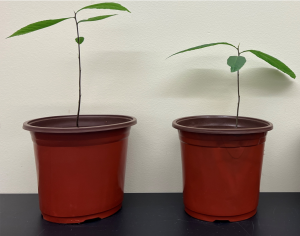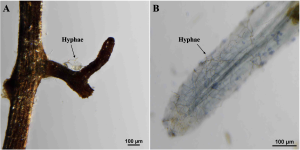Truffle Fungi Promote Pecan Seedling Growth

Figure 1—Truffles found in the orchard in Oklahoma.
This finding sparked extreme interest as our team focuses on pecan mycorrhizal fungi research. We seek to investigate a means to increase the uptake efficiency of nitrogen and other nutrients by pecan roots using mycorrhizal fungi. Pecan trees have fine roots but primarily rely on mycorrhizal fungi to absorb water and nutrients. Several previous studies have reported the superiority of mycorrhizal fungi on pecan growth and water utilization by improving leaf biomass and stem height and diameter (Babuin et al., 2016; Tarango et al., 2009).
Roots in some pecans may form ectomycorrhizal associations with fungi belonging to the divisions Basidiomycota and Ascomycota, such as species within the genus Astraeus, Gyrodon, Pisolithus, Russula, Scleroderma, Tuber, and Tylopilus (Bonito et al. 2011). The research by Bonito et al. also showed truffle genus Tuber, including Tuber lyonii, is naturally abundant in fungal communities of many pecan orchards in Georgia. Our study investigating the diversity of pecan rhizosphere microbial community at OSU experimental orchard in Perkins, Oklahoma, also indicates Tuber is the most abundant fungal genera in this orchard; the average relative abundance of Tuber is 23%. In our results, Tuber lyonia and another undescribed Tuber species were detected as the dominant species in pecan roots of all trials. Tuber lyonii, also known as Butter Truffle, is a type of truffle fungus highly valued for its aromatic and flavorful qualities. It is considered a delicacy in many culinary circles.

Figure 2—A pecan tree with inoculation of truffle fungus on the left versus on without inoculation on the right.
We used these truffles sent by Leva Swim to inoculate lab-germinated pecan seedlings. Pecan nuts were sterilized and germinated in sterilized sand. After germination, the pecan seedling was transferred to plastic seeding pots with the sterilized substrate. The pots are shown in Figure 2, and seedlings were well cultivated in a moderate environment. When the seedlings are three months old, we inoculated ground truffles and took care of the seedlings to continue growing in pots.

Figure 3—Under microscope, pecan seedling roots inoculated by truffle fungus were observed growing with fungal hyphae. It means this truffle fungus was formed on pecan roots.
Interestingly, after 6 months of incubation, the pecan seedlings with fungus grew higher than those without fungus application. We also observed a symbiotic relationship between the fungus and inoculated pecan seedlings. Figure 3 showed the presence of fungal hyphae covering the root tip. Our current study revealed that truffle fungi, as a type of ectomycorrhiza, can be inoculated artificially to pecan seedlings and trigger pecan growth.

